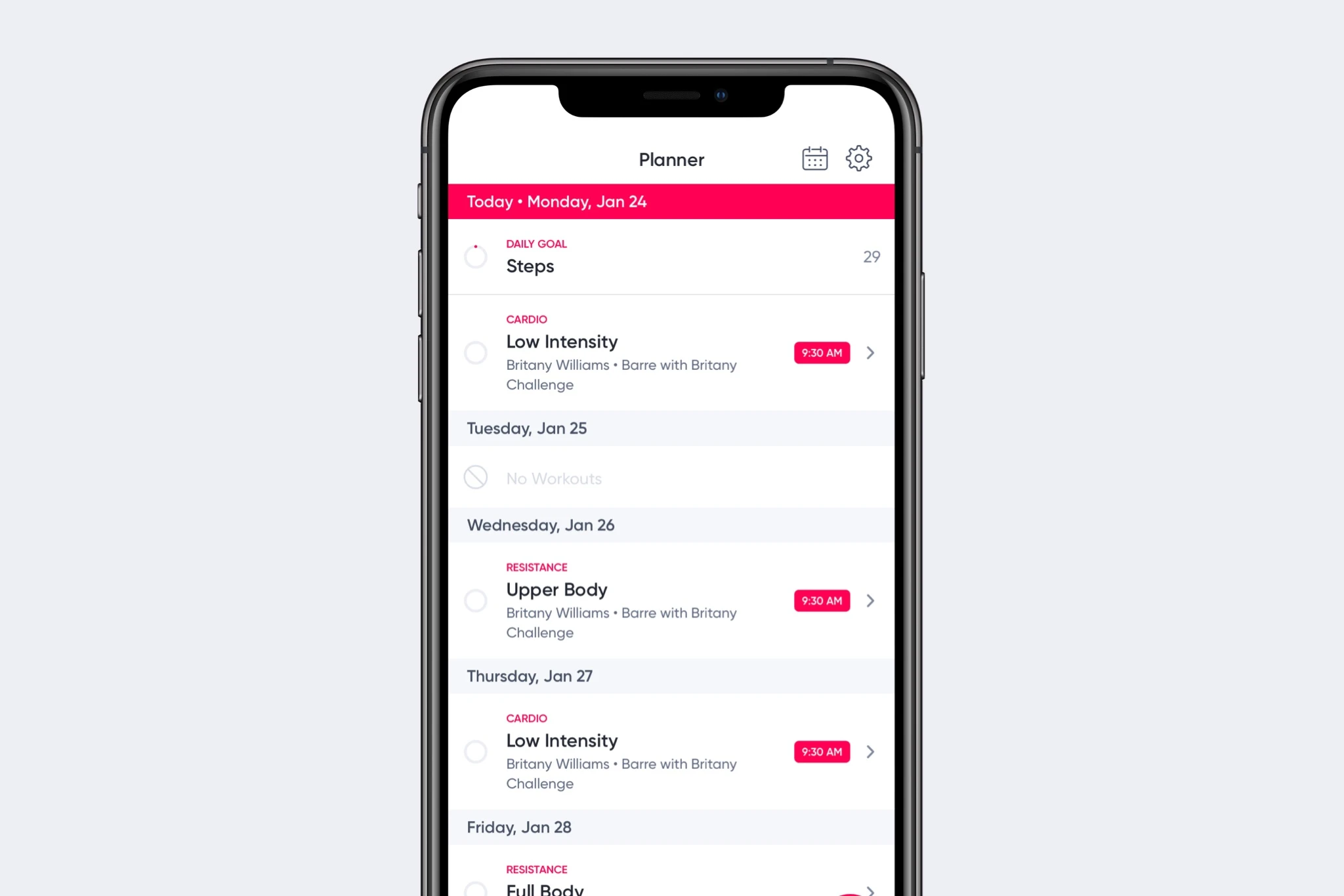How To Make A Workout Schedule That Works For You

January 25, 2022

Getting into a regular exercise routine can have a huge range of benefits, such as improved sleep and energy levels, as well as better posture, brain health and stress-management. Not to mention the feel-good factor that comes from the endorphin rush and the satisfaction of completing a workout!
As your life, fitness level and goals change, it’s normal for your workout routine to change too, but it can be confusing to know how to schedule your week to get the balance right. You want to reap all those benefits and see results, while also making sure you have enough downtime to rest and avoid injury or burnout.
Understanding how to create a workout schedule that works for you is a key part of getting the most out of your training sessions and recovery, as well as setting yourself up for long-term success.
At any stage of your fitness journey, it’s common to wonder things like, how many days a week should I be working out? What is the best time of day to workout? How much rest do I need in between workouts? Is stretching and foam rolling important? How much cardio vs. strength training should I be doing? Does HIIT need to be part of my routine? How long do my workouts need to be?
Because everyone has different fitness goals, starting points, and time available to spend exercising, there are no hard and fast rules or a one size fits all approach when it comes to creating a great routine. The most important thing is finding a sustainable routine that works for you and one you enjoy.
Beyond that, there are some general tips for creating a balanced workout schedule to help build your strength and fitness. We also got the lowdown from the team at Sweat on how they structure the Sweat programs to help you get the most out of your week.

How often should you workout?
Figuring this out comes down to your goals and current fitness level. In an ideal world, everyone would have plenty of time each day to get moving, but we know that’s not always the reality. That’s why the Sweat app is packed with efficient workouts to fit any schedule.
If you’re fit and active already, then three to six workouts a week will probably be your sweet spot to maintain or continue building your fitness, depending on the intensity and training style. If you’re new to exercising or are coming back from a break, you may want to start with two to three sessions a week to build your fitness and give your body time to recover - we don’t want you burning out in week one or feeling constantly sore! Once you feel ready to progress, you can dial it up.
If you’re starting out with a couple of workouts each week, you can also add in some more gentle forms of movement like walking, cycling or stretching. This will help make exercise a habit without putting too much strain on your body too quickly.

What time of day is best to workout?
The best time of day to exercise is whenever you can fit it in or feel your best - everybody is different! You might love to get your workouts done and dusted straight away, while your best friend might find it too hard to squeeze in an early morning session or have more energy in the afternoon.
It helps to look at your schedule at the start of the week to find the times when it will be easiest to commit and make a plan.
The Planner in the Sweat app is an awesome place to plan and keep track of your schedule. You can use the suggested workout plan or set your own, and use it to keep track of your schedule, steps, and completed activities in either a weekly or monthly view.
When planning your week, it can help to think about what time of day you feel most energetic. Would you rather start or end your day with a workout, or do you prefer a lunchtime Sweat to break up the day?
However your unique body ticks, use it to your advantage. It will make your workouts far more enjoyable, and you’ll be more likely to stick with it in the long run.
What sort of exercise should be in your routine?
To build general fitness and strength, we recommend a mixture of cardio and strength training. Alternating between the two is a good way to strike a balance and reap the rewards.
Strength training has many amazing benefits, such as promoting your heart health, increasing lean muscle mass and improving bone density.
If you have access to a gym or equipment at home, great! But don’t worry if you don’t - many strength exercises can be done with your body weight, and you can turn up the difficulty by increasing reps, or trying more challenging variations. The Sweat app has a number of programs which are designed to be done at home with no equipment, while other workouts offer exercise modifications you can use if you find yourself without your go-to equipment.

As a general rule, it’s good to start by alternating your exercise days between cardio and strength training to give your muscles time to recover if you’re doing full-body workouts.
For those wanting to complete more than two strength training workouts a week or train on consecutive days, it’s a good idea to alternate muscle groups on different days, such as lower body, upper body, and core/abs.
If you’re new to strength training, we also recommend getting comfortable with the fundamental movements first (such as push-ups, lunges and squats) before you tackle anything more advanced. The Sweat app has detailed instructions and demonstrations of each exercise, as well as recommended reps or time.
Get your cardio in however you like - this could be a brisk walk, run, bike ride, swim, dance, or even jumping around with a skipping rope. If you prefer to exercise indoors, jump on a treadmill, bike, rower or elliptical machine. Experiment and see what (and where!) you like to move your body, or change it up each week to keep workout boredom at bay.

How many rest days a week should you have?
Even if you feel fit and strong, you should still aim to have one or two rest days each week. As the Sweat Trainers like to remind us - muscles rebuild and recover in the downtime, not the workout time, so getting adequate rest is really important if you want to see progress and avoid injury or burnout.
The Supercompensation Curve is a sports science theory that explains this well. In his book Athletic Development, Vern Gambetta - an internationally renowned training and conditioning expert - defined this model as a process involving training and fatigue, followed by recovery and the supercompensation phase.
After training, there is a predictable drop in performance due to fatigue, and as a result of rest and recovery, performance and energy will return to your baseline fitness level. Then your body adapts and goes above this baseline level, and your fitness improves.
If you train those same fatigued muscles before they have had time to recover, they may break down further, send your progress backwards or increase your risk of injury. We’ll say it again - rest and recovery are both essential for fitness progress and strength gains.
Making time for recovery sessions with stretching or foam rolling can also have a positive impact. If you’re young or your fitness level is high, it’s easy to feel like your body is invincible and you can power through a daily workout, but we’re in this for the long game! The best healthy habits are the ones you can sustain.
If you start to feel fitter and stronger, should you do more workouts to progress?
If you’re doing a couple of workouts a week and are feeling great, that’s awesome! Now is a great time to add another workout or two to your weekly schedule.
If you’re already doing four to six training sessions a week and are feeling good, rather than adding more workouts, simply turn up the difficulty. As the saying goes - quality over quantity.
“The fitter you get, the more consecutive days you can train before you need a day off, but rest is still important,” our exercise science team explains.
Increasing the difficulty by incorporating progressive overload could mean increasing your reps or weight, trying more challenging variations (like taking push-ups from your knees to your toes), or reducing your rest time throughout the workout. When it comes to exercise frequency, more isn’t always better, and can put you at increased risk of injury or burnout.
The bottom line is, your workout schedule needs to work for you. Some weeks you might find you only have time for one session, and that's okay! Using the Sweat app you can always repeat the previous week or reset the week you're on. Are you ready to make a plan?

A more empowered you starts with Sweat, and our editorial team is here to bring you the latest fitness tips, trainer recommendations, wellbeing news, nutritional advice, nourishing recipes and free workouts.
* Disclaimer: This blog post is not intended to replace the advice of a medical professional. The above information should not be used to diagnose, treat, or prevent any disease or medical condition. Please consult your doctor before making any changes to your diet, sleep methods, daily activity, or fitness routine. Sweat assumes no responsibility for any personal injury or damage sustained by any recommendations, opinions, or advice given in this article.
Fitness